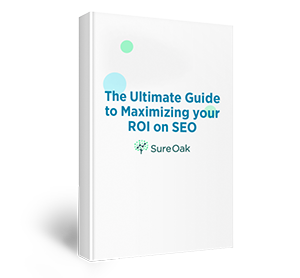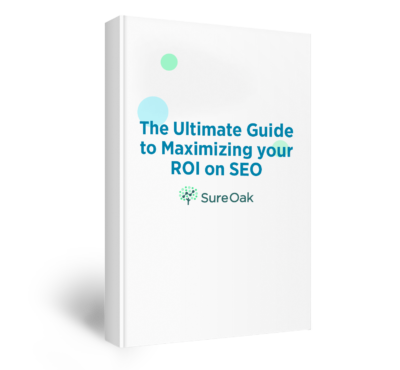With the fintech industry growing year after year, the competition for online visibility and ranking in search engine results has become fierce. A solid SEO strategy is key to staying ahead of the competition. What fintech SEO strategies can you implement to stand out and rank on top of your peers?
Let’s dive into:
- Why fintech SEO is vital for increasing brand visibility.
- Top 10 effective but commonly overlooked fintech marketing strategies to stay ahead in the SEO game.
- The biggest optimization challenges in fintech and how to overcome them.
- The easy way to implement fintech SEO effectively and get results quickly.
Why Do You Need SEO for Your Fintech Company?
Search engines like Google see billions of searches per day. Many people behind those search queries are potential customers. SEO for fintech is an excellent opportunity to expose your brand to a wider audience and generate more leads for your company.
The best part is you can increase brand awareness and attract new leads consistently without paying for clicks on result pages. Instead, your website ranks organically based on relevance to search queries. This makes fintech marketing more cost-effective.
Additionally, optimization helps you stay competitive. Top fintech companies leverage search engine optimization to reap the benefits — and you should, too. If you don’t, you risk being left behind and missing out on organic visibility.

Fintech SEO Strategies You Should Be Using
You can drive more organic traffic to your website by ranking for new and existing keywords or getting more clicks on result pages. The fintech SEO strategies below help you do all of this and more.
1. On-Page SEO
On-page SEO involves anything you do on a web page (or internally) to rank better in search results. Here are techniques for on-page optimization.
Create Value-Packed Content
High-quality and high-value content matches your customer’s search intent, but how do you create it?
Conduct thorough keyword research to identify target terms and relevant topics that address your audience’s needs. Keyword research tools like Semrush and Ahrefs can help identify topics to cover. From here you can create blog posts, social media posts, lead magnets, and more to drive your website traffic and encourage leads.
Place Target Keywords Strategically
After finding the target keywords, use them in header tags (H1), subheaders (H2, H3, H4, etc), and in the introduction paragraph of a web page. This strategic placement provides context for search engines and helps web visitors to quickly know if a piece of content provides the information they want.
Keywords can also help search engines figure out what your webpage is all about, and if the search engine deems it useful information, it will boost your rank in search results.
Write Keyword-Rich Title Tags and Meta Descriptions
A title tag tells search engines the topic of a web page. Meanwhile, a meta description appears below title tags in search results and briefly summarizes your page’s content. Optimizing these elements with target keywords shows potential customers that your content meets their search intent.
Add Internal Links
Internal links point from one web page to another on your website. They help Google understand how your web pages relate to each other. They also encourage users to explore different sections of your website, which can increase the time they spend there.
Avoid Keyword Stuffing
Using the same keywords, or too many variations of the same keyword can actually hurt your ranking. This is called “keyword stuffing”, or stuffing a page full of keywords in the hopes that the search engines will rank your page.
Keyword stuffing is a form of Black Hat SEO, or negative SEO, and it can hurt your rankings. Google sees this as a way of trying to manipulate the search engine and will penalize pages that seem like they are using too many keywords for rank instead of providing helpful content.

2. Website Schema
Website schema, also called structured data or schema markup, is a special code you add to your web pages. This helps search engines better understand your site and display its content in a more detailed format on result pages.
For instance, Google can show rich snippets about your financial product, such as reviews, star ratings, and number of votes, directly in search results if you use schema markup. The extra details can make a web page stand out and may increase your click-through rate.
However, the additional details that appear on result pages depend on the types of schema markups you’ll use. Choose the appropriate ones based on the nature of the content on each web page.
To generate schema markup, you can use tools like Google’s Structured Data Markup Helper and implement the resulting code on your own. But if you need professional help to create and deploy it correctly, seek advice from a fintech marketing agency specializing in SEO.
3. Improve User Experience (UX) on Your Website
According to Google, web page UX is a core ranking factor. To help you measure and improve user experience on your site, the search engine giant introduced a set of metrics called Core Web Vitals. They focus on aspects like:
- Loading speed: To provide a good user experience, the main content on a web page (e.g., block of text or image) must load within the first 2.5 seconds. Consider reducing the size of photos, using proper photo formats (.webp), and implementing advanced techniques like lazy loading to increase page load speed.
- Interactivity: This measures how quickly a user can interact with web page elements, such as clicking buttons after it starts loading. Interactivity should occur in less than 100 milliseconds for a good UX.
- Visual stability: This measures how often users experience sudden layout shifts when a page loads. These shifts can happen when someone reads text on a web page, and suddenly, an ad pops up, pushing the content upwards or downwards. This frustrates users. To prevent this, set dimensions for media and reserve specific spaces for ads when you use them on a web page.
When analyzing the UX of specific web pages, a Google Search Console report shows whether Core Web Vitals metrics are poor, good, or need improvement, and it will give you details of the areas that you need to improve.
4. Optimize for Mobile
Google uses Mobile-First Indexing which prioritizes mobile-friendly web pages. Mobile-friendliness requires a responsive web design that can adapt to a searcher’s screen size. It ensures mobile users can read your content without horizontal scrolling or zooming.
Another way to optimize your site for mobile is to ensure the content on your website’s desktop version is the same on mobile. This ensures the two versions can rank for similar keywords.
You can utilize the Mobile-Friendly Test tool to assess a particular web page.

5. Your Money or Your Life (YMYL)
The term YMYL originates from Google’s guidelines for quality evaluators. It refers to sensitive topics that could impact users’ financial stability, health, or safety. In fintech, for instance, Google might consider pages about investing, banking, and taxes as YMYL.
Search engines have higher ranking standards for YMYL content. The content must demonstrate the highest level of experience, expertise, authoritativeness, and trustworthiness to rank better on result pages.
Best practices for YMYL include:
- Ensuring your content is from qualified professionals (or authors with deep industry knowledge). Showcase their credentials and experience at the top of pages with YMYL content.
- Provide accurate content and cite credible sources to enhance trustworthiness. For instance, support claims with reputable studies, surveys, or research papers.
- Get mentions on authoritative websites. Mentions from expert sources, such as professional societies, are strong evidence of a positive reputation.
6. Experience, Expertise, Authoritativeness, and Trust (EEAT)
EEAT comes from the same place as YMYL. Google uses it to assess the credibility and reliability of search results. To show search engines that your website is credible and deserves a spot on the first result page, your content must demonstrate:
Experience
The author or content creator should showcase first-hand experience on the topic. This is important in proving that the insights in a web page are tried and tested.
Expertise
Since fintech content can impact a user’s financial status, it needs to be created by someone with topical expertise. Does the creator have the credentials, qualifications, or deep knowledge to provide reliable information?
Authoritativeness
Authoritative websites are trusted as good sources of information. Earning reputable backlinks can help build authority in your niche.
Trustworthiness
Trustworthiness is the most crucial part of EEAT. For Google to trust your website, your content must be accurate, honest, reliable, and safe (in other words, it doesn’t cause financial harm when users implement your advice). It’s also a best practice to show who wrote the content and only link to trusted sources.
7. Create a Solid Content Strategy
A content strategy is the road map you follow to create content that addresses your audience’s needs and aligns with business goals. But how do you create an effective one?
- To start, identify what you want to achieve in a specific period.
- Next, define your ideal prospects. Pinpoint their demographic, preferences, and the pain points that keep them awake at night.
- Once your business objectives and customer profiles are clear, you need to do keyword research. The aim is to identify and write about topics that address your audience’s needs, align with your goals, and are optimized for search engines.
- After creating optimized content, track its SEO performance using tools like Google Analytics or Google Search Console. Monitor key metrics, such as traffic, engagement, keyword rankings, and conversions. Use the insights to refine your content strategy and drive continuous improvement.

8. Establish Backlinks from Reputable Sites
Backlinking is when another website links to yours, and it is one of Google’s strongest ranking factors. However, not all backlinks are equal. Those from spammy or low-authority sites will hurt your ranking on search results.
You should strive to build backlinks from reputable websites with a higher online authority than yours. According to Google, doing so shows that your website is trustworthy and credible. The more high-quality backlinks you have, the more likely your site will rank higher on result pages.
An SEO tool like Semrush offers a link building tool to help you identify credible websites that might link to yours. It also provides an audit tool to identify bad backlinks so that you can disavow them on Google Search Console.
9. Improve Your Click-Through-Rate (CTR)
Ranking at the top of search results or reaching the first page of Google is half the work. The other half is getting people to click the link leading to your website and then stay on your website. The more people click around your website, the higher your click-through rate.
One way to improve CTR on result pages is to write a compelling title tag. The title should be click-worthy (accurately reflecting your webpage’s content) instead of clickbait.
What’s more, search engines will cut off titles that are too long, making some words invisible to searchers. For your titles to be fully visible (and, therefore, as persuasive as you intend them to be), ensure they are about 50 to 60 characters. Tools like highervisibility and Moz Title Tag Preview Tool can help optimize your title tags.
10. Optimize Your Sitemap
A sitemap is a file that lists all the pages on your website. It helps search engines understand your site’s structure and index your content more efficiently. While there are different types of sitemaps, the best practices for optimizing all of them are the same.
- A sitemap should not exceed 50 MB or contain more than 50,000 URLs. If yours is larger or contains more web page links than this, Google says you must break it into multiple sitemaps.
- Include all relevant web pages you want to see in search results.
- Ensure URLs are accurate and crawlable.
After optimizing your sitemap, submit it for indexing via Google Search Console and Bing Webmaster Tools.
Fintech SEO Challenges to Overcome
While the core principles of search engine optimization are the same for all industries, some aspects of fintech SEO make it more challenging.
For instance, the financial technology sector is a rapidly growing industry. So, some of the keywords financial tech companies try to rank for are among the most fiercely contested on the internet. This makes it hard for fintech startups to appear on organic search results.
Additionally, Google considers fintech topics as YMYL because they can impact the financial status of users. That means your content must meet the highest authority, expertise, and trustworthiness standards to rank higher on search results.
Meeting these requirements can be difficult, especially if you lack advanced optimization skills or are unsure how to compete with authoritative, well-established competitors.
Partnering with a fintech SEO agency gives you access to specialized expertise and experience in search engine optimization.

Choose a Fintech SEO Agency Who:
Is Up to Date on the Latest Fintech Trends
Staying ahead of the curve ensures your SEO strategy adapts to industry changes and Google algorithm updates, helping you maintain or improve your ranking on search results.
Has Experience Working with Fintech Startups
You want an agency that has worked with many companies like yours before and helped them achieve their SEO goals. That way, you know the agency has what it takes to navigate fintech SEO challenges.
Will Help You Come Up With an SEO Long-Term Strategy
SEO for fintech is a long game. The right agency will help you build a strategy designed for long-term success so you get consistent organic traffic over time.
Will Help You Reach Your Fintech Digital Marketing Goals
Choose an SEO strategy agency that listens to your goals and tailors its expertise to meet your business’s unique needs. You want a result-driven partner who can help you boost website traffic, improve lead generation, and increase conversions.
If you implement all of these different strategies correctly, you should see a significant increase in your rankings. However, know that SEO can take time to work, so the results won’t happen overnight. If after several months, you still aren’t seeing the results you expect, you may need to reanalyze your strategies again, or it may be time to call in a professional.
If you have more questions, or you’re ready for professional help, contact us. Sure Oak can help you get on the first page of search engine results, attract more leads without spending on ads, and boost your profitability.





